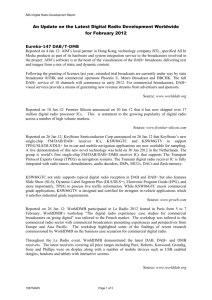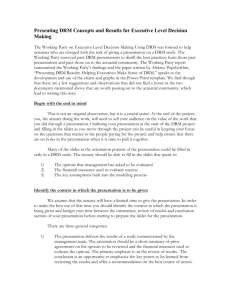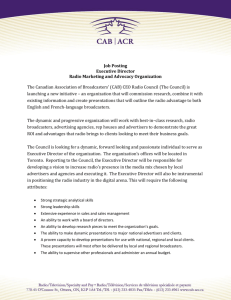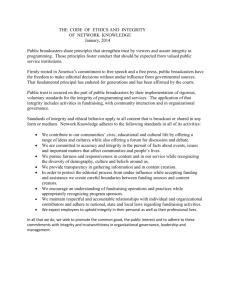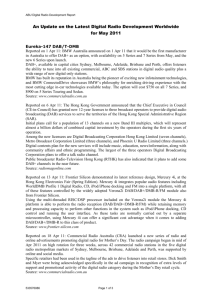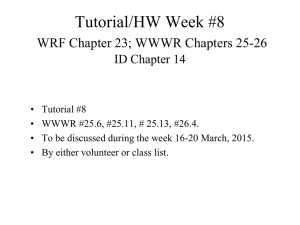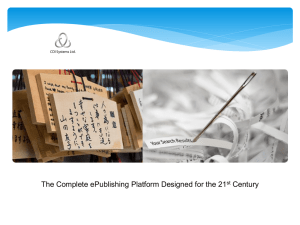Alan Hughes Submission to DOC's Discussion into Digital Radio
advertisement
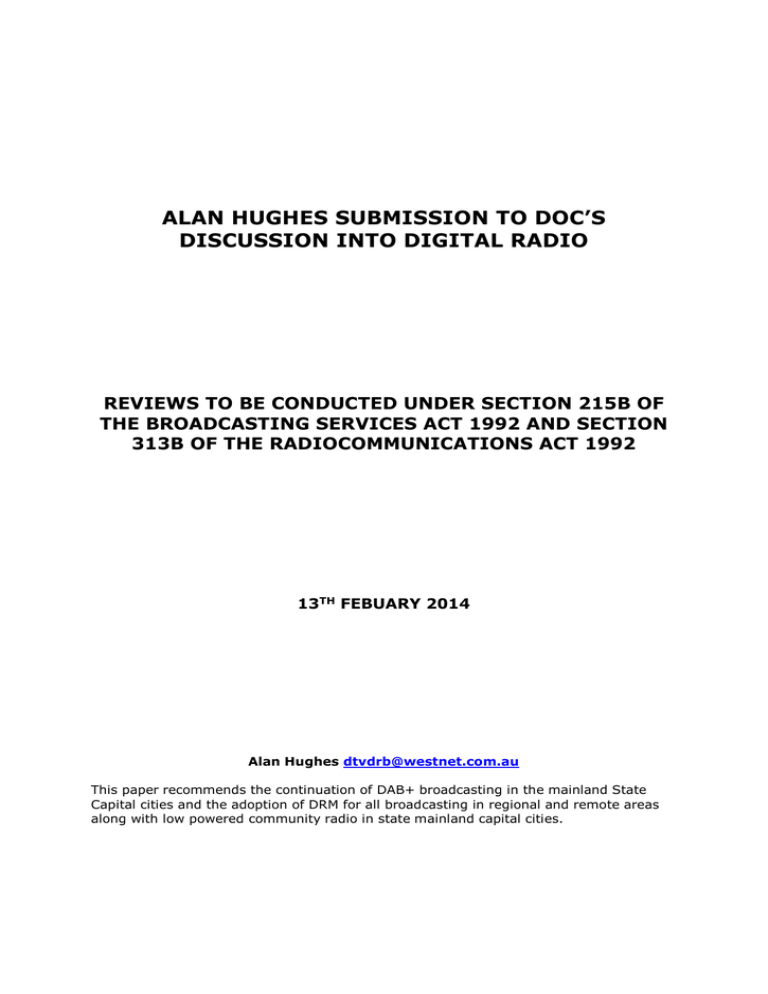
ALAN HUGHES SUBMISSION TO DOC’S DISCUSSION INTO DIGITAL RADIO REVIEWS TO BE CONDUCTED UNDER SECTION 215B OF THE BROADCASTING SERVICES ACT 1992 AND SECTION 313B OF THE RADIOCOMMUNICATIONS ACT 1992 13TH FEBUARY 2014 Alan Hughes dtvdrb@westnet.com.au This paper recommends the continuation of DAB+ broadcasting in the mainland State Capital cities and the adoption of DRM for all broadcasting in regional and remote areas along with low powered community radio in state mainland capital cities. Questions: Part 1: The regulatory framework 1. Is the licensing and planning framework for digital radio operating effectively? Should any changes be made to the regulatory framework? a. Firstly the Department of Communications in its various forms and its Ministers, Commercial Radio Australia, broadcasters, TXA and Broadcast Australia are to be congratulated to have taken the bold step to be the first full time high power broadcasters using DAB+ anywhere in the world where there were very few receivers at the time the decision was made. b. The following should be commended; c. i. The use of the same radiated power as digital TV to give a coverage area almost the same as digital TV which is nearly all the licence area. These are the highest powered DAB+ transmitters in the world. ii. The simulcast of all existing licence area wide broadcasts with additional programs. This is particularly important for AM broadcasters because it is rare for a DAB+ digital radio to receive AM broadcasts. In addition the sound quality improves to be the same as FM broadcasts. iii. Starting digital radio for the mainland State Capital cities covers 60 % of the Australian population gives the most cost effective coverage for a fledgling system. iv. The provision of free spectrum for the digital broadcasts for startup. v. The recent licencing of On-channel Repeaters is allowing broadcasters to fill in black spots in the coverage area within their licence area. Laws will need modification. i. Limitations of the existing plan 1. Digital Radio Switchover Simulcasting of all existing broadcasts is an expensive duplication, (both in power and maintenance costs) as the TV industry found, and as a result all analog TV transmitters have now been switched off. The conversion from analog to digital was successfully achieved with virtually no public complaint. Look at what happened to receiver prices once the analog switchoff became obvious to viewers and retailers. Set top boxes started off at well over $1000 in 2001 and last year were less than $40 retail. Alan Hughes Submission 2 On 4th Feb 2011 Norway1 (Population 5 million) decided to switch off analog radio by 2017, All India Radio2 (Population1,200 million), 2017 and Denmark 2019 (Population 5.6 million).(Australian population 23 million) Radio should follow USA TV switchover model. Implementation: Radio should copy the model used by the U.S. for digital TV (DTV). 1. Select a switch off date. (Congress selected a date 10 years ahead however it was delayed an extra three years due to poor public awareness.) 2. Select a start date after which all new devices must comply to the latest ETSI standards at profile level 2 as specified by DRM, including 45 – 108 MHz DRM+ reception. A device includes all radios capable of receiving broadcasts, including: a. factory installed and after-market auto radios, b. mobile phones, c. tablets, d. home theater amplifiers e. portable playing devices. (Congress set this date two years prior to switch off. On reflection this date should have been half way between switch off and the decision to switch to digital. This earlier date reduces the need for subsidies to receiver purchasers.) We do not wish to subsidise receiver purchases thus the legislation requiring the above devices to be capable of DAB+/DRM reception well prior to the analog switchoff is important. More on this later ii. The limitation of 8 DAB+ transmission channels, severely limits the possibility of future growth, at the power used (50 kW effective radiate power), the channel cannot be reused within 336 km of an existing transmitter (ACMA Technical Planning Manual). The 336 km is to prevent interference the reliable coverage area has a diameter less than 80 km depending on the terrain. 1 http://www.worlddab.org/system/news/documents/000/001/347/original/Press_release_Digitalradio_Norway.p df?1377939172 2 http://allindiaradio.gov.in/Services/Digital%20Transmission/Pages/simple.aspx Alan Hughes Submission 3 Note that digital television in Sydney, Canberra, Manning River and Bathurst prevent the use of any DAB+ channel outside of 8A – 8D, 9A – 9D from being used for radio. I have allocated a DAB+ channel to each high powered TV/FM transmitter site. With the exception of Newcastle, which has 4 broadcasters all others only have two broadcasters nearby. Compare this to Sydney, which has 11 companies sharing 2 transmitters. Alan Hughes Submission 4 Alan Hughes Submission 5 The dots show the primary program source, there may be repeaters which are not shown. ABC/SBS/HPON transmitters are not shown. Band 3 Digital TV is also shown because the same spectrum is used for digital radio, although the ACMA is clearing DTV from DAB+ channels 8A – 9D Alan Hughes Submission 6 DAB+ Channel AU DTV channel DAB+ Channel AU DTV channel 5A – 5D 6 9A – 9D 9A 6A – 6D 7 10A – 10D 10 7A – 7D 8 11A – 11D 11 8A – 8D 9 12A – 12D 12 iii. In the Brisbane, Sydney, Melbourne and there surrounds, there is only one spare transmission channel. This is insufficient for the ABC/SBS to have their own unique transmission channel on each regional site. So a Single Frequency Network where all transmitters have identical signals including all programs will be required. It will require the ABC to hire part of the commercial station multiplex to transmit local radio in each region. iv. The ABC/SBS are currently using all of the data capacity available on their transmission channel. If only one DAB+ transmitter were to be installed at these high powered transmitter sites, it would mean that ABC/SBS would have to restrict some of its programming to metropolitan areas to make space for the commercial radio programs. v. All radio broadcasters should now be required to transmit an alternative frequency table using AMSS for AM broadcasters and RDS for FM broadcasters. As an example in Parliamentary News Network in Sydney has the following details; 206.352 MHz (Digital channel 9C) ABCNewsRadio DAB+ 630 kHz AM (Sydney) 92.5 MHz FM (Gosford) 90.9 MHz FM (Illawarra) 1458 KHz AM (Newcastle) 91.3 MHz FM (Lithgow) This table is very important in vehicle receivers, because the receiver when ABC NewsRadio is selected will look for the signal on channel 9C, it is not sufficiently error free, the receiver will look for the same program from the other transmitters listed above. When the digital signal reappears, the radio will automatically switch back to digital. 2. Should the provisions concerning the commencement of digital radio services be modified or removed, allowing broadcasters to commence services whenever they wish (subject to spectrum planning considerations)? a. The ACMA auctions spectrum including broadcast spectrum. There are 3 groups of broadcasters. This has become complex. Spectrum auctions are for frequencies so in the DAB+ case a transmission channel is 1.712 MHz. The complication is that this bandwidth contains a number of data channels. The current laws make separate rules for commercial, national and community broadcasters. For commercial broadcasters they are allocated 128 Mbit/s each. It is up to the broadcaster how this data is Alan Hughes Submission 7 used. It could be all used for a single program or for multiple programs with poorer audio quality or for data. DRM channel can be 0.018, 0.020 or 0.1 MHz, so should these transmission channels be charged accordingly to the quantity of spectrum used compare to the 1.712 MHz of DAB+? The last complication is that the higher the data rate the better the sound quality, so charging licencing fees on data rate will make deter broadcasters from transmitting better quality. The only way to do this is to charge a standard way such as for a 128 kbit/s sound program and then a $/data rate for data for other applications. I have selected 128 kbit/s to allow for the transmission of good quality surround sound. i. Existing broadcasters in existing digital licence areas ii. Media concentration will prevent these broadcasters from new licences, however. From the 1st July 2015, broadcasters are to pay ACMA licence fees for their digital broadcasts in addition to the licence fees for their analog licence. The broadcasters should then be allowed to cancel their analog licence. This is to encourage broadcasters to convert to digital rather than wasteful simulcasting for an indeterminate period of time. The broadcasters will also promote the sales of digital receivers. iii. Existing broadcasters in all areas outside existing digital licence areas. (regional and remote areas) These broadcasters should be given the same conditions as was given to the original digital broadcasters. “6 years of free digital spectrum and no new competitors.” iv. New broadcasters In existing digital licence areas after next year, just be part of the auction of data rate if there is any available. In new areas, they have to wait 6 years from the start date then the above conditions apply. 3. Is the access regime established in Part 3.3 of the Radiocommunications Act operating effectively? Is the system of access undertakings working as it should? a. 4. Paragraph 118NQ refers to commercial broadcaster having the right to 1/9th of the transmission channel’s multiplex. This turns out to be 128 kbit/s. Compressed sound and even more so datacasting can use parts of this 128 kbit/s. 118NQ e “is not entitled to transfer the digital commercial radio broadcasting licencee standard access entitlement” Does this also mean part of their entitlement for example traffic data for GPS systems or infact another sound program from a competitor broadcaster? Should any of the provisions relating to the access regime be amended or replaced? a. Firstly I would like to say this section of the act needs to be edited to make it comprehensible. Paragraph 98A and 9A refer to datacasting channels, it makes no mention that these were designed for TV channels which are 7 Alan Hughes Submission 8 MHz wide where as DAB+ radio channels are 1.7 MHz wide and DRM radio are either 100, 20 or 18 kHz wide. Since the restack there is no spectrum for datacasting channel B and datacasting channel A has been turned into Unassigned TV channel. The advertorial channels on commercial TV networks are authorised as datacasting “channels” but are multiplexed program streams fed into that broadcasters transmitters along with their normal licenced programs. Now that there is no analog TV in this country except for community TV in remote aboriginal settlements, all of the simulcast clauses need removal. b. Paragraphs 98C and 98D should only be foundation licences until may next year. Then they will no longer be “foundation” They should be labelled as being for DAB+ broadcasting. They only apply in mainland state capital cities where DAB+ is being used. It does not apply to DRM licences which may contain a pair of sound programs just like the pair used on analog AM and FM now. c. The Paragraph118 NQ 2e 128 kbit/s per broadcaster should be retained on DAB+ transmitters, on DRM the entire data rate should belong to the broadcaster. (DRM+ offers from 37.2 – 186.3 kbit/s or for lower frequency channels 10.2 – 72 kHz depending on the channel width and the robustness required.) d. A DAB+ can carry 1152 kbit/s of data which could be compressed sounds, broadcast relate data and independent data. So for paragraph 118NR 2, 2/9ths is 256 kbit/s. Thus paragraph 118NR 8’ s designated fraction is as follows where the result is in kbit/s. If the result is below 64 kbit/s the broadcaster must use Spectral band replication (SBR) and parametric stereo in the encoding along with stereo programing including microphones in speech only broadcasting to improve the sound quality at low bit rates. An examination of the transmitted data rates in Perth, where there is only one category 1 licence, the commercials correctly use 7 x 128 kbit/s, but the community broadcasters are trying to use 336 kbit/s or more than their 256 kbit/s. This may explain why low data rate broadcasts have a phasing effect on violin and like type instruments due to the omission of data caused by the excessive community radio settings. This problem does not exist on the same lower data rates on the SBS broadcasts. e. A DRM community digital radio licence which can cover the same licence area must also be offered as an alternative to a DAB+ licence where the designated fraction has a result of less than 128 kbit/s must also be offered by the ACMA. f. 118NS use an entire multiplex with the ABC using 66 % and SBS 33 % and there is only 8 kbit/s unused. g. All references to start up days and if there is insufficient demand be removed from the act as this period is over. Alan Hughes Submission 9 5. h. A new section is required for non-mainland state capital cities to cover regional and remote areas along with low powered community broadcasters in the mainland state capital cities. In regional and remote areas where DRM is used the broadcaster has access to all of the data capacity of their transmission channel. In low powered DRM a pair of broadcasters covering the same licence area may share the data capacity of a DRM transmitter operating above 30 MHz. i. All broadcasters who broadcast on digital must transmit an alternate frequency table on both their digital transmissions and there analog transmissions (using AMSS on AM and RDS on FM). Are the reasons for a moratorium on new licence area planned commercial digital radio licences still valid? Should the moratorium, which is due to expire on 30 June 2015, be extended or discontinued? a. There are virtually spare channels available in existing digital licence areas, all other areas they should be allowed 6 years for the same reasons. The addition of DRM will allow a lot more licences to be available. Alan Hughes Submission 10 Part 2: Restricted Datacasting There appears to be a misconception about datacasting. All digital radio systems are designed to transmit sound, still pictures and video simultaneously. A broadcaster could fill an entire transmission channel without sound if required. Types of standardised data broadcasting which can be added to a channel carrying a sound signal. Electronic Program Guide – should be bundled with the sound licence. Very advantageous to the ABC & SBS and some community broadcasters particularly, because of their varied content. Traffic Message Channel – This is used by GPS navigation systems in vehicles to redirect the driver around blockages, may be separately licenced, and the licencee may have to negotiate hiring data capacity with an existing transmitter owner. Differential Global Positioning System – can describe an area. This is good for the Emergency Warning System to only direct the message to the area concerned, but could also be used to direct advertising to specific areas. All Smartphones contain a GPS receiver so these phones can respond to this system. Radio manufacturers should be encouraged to put GPS receivers into all radios. This could be included in the Australian standard for DAB+ and DRM receivers. Emergency Warning System – This is a public service for cyclone, bush fire, flood messages including text and maps… Interactive Text Transmission System This channel is one way but could be used in conjunction with a backward link trough a phone or the internet. This could be used by survey companies and advertisers. Some privacy controls may be necessary. Paging could be used for a profit, may need regulation. May not be that popular due to SMS in the phone network. Could be used in an emergency when the mobile phone towers are burnt down…. Transparent Data Channel – May or may not be related to the sound broadcast Video Transport Stream for the transmission of moving pictures of low resolution. Embedded Internet Protocol packets. This allows applications to reduce the data traffic on the phone. Data capacity in the phone network will become scarcer and more costly. Multimedia Object Transfer Usually used for showing “Powerpoint slide shows” They can be program related, particularly advertising Journaline® news service. Should this be owned by the broadcaster or be hired out to a new entrant newspaper and not an existing paper based newspaper? Proprietary service could be hired out. 6. Should there be any changes to the initial restricted datacasting framework? Only encouragement to transmit some of the above datacasting for example multimedia to show album covers and advertising Alan Hughes Submission 11 7. Given that the ACMA has not issued any restricted datacasting licences, is there any future for such services? Perhaps traffic messaging, targeted advertising including pictures and text, but this requires the receiver to have a GPS receiver included, however all Smart phones have these. This would be successful if Commercial Radio Australia is successful in getting phone manufacturers to put a digital radio receiver chip in each new phone. 8. How can restricted datacasting be made more attractive to new entrants to the market? Offer traffic messaging3 for a start, however Journaline with multimedia for pictures4 may struggle against the wireless internet. 9. Should there be additional spectrum allocated for restricted datacasting services? Given the major restriction of a single spare DAB+ transmission channel in areas of high population density, it doesn’t give a lot of options unless DRM+ is also used. The only possible candidate is for traffic updates for major cities for a fast and very detailed, allowing rerouting of traffic in a controlled way. Part 3: The Technological Environment and Audience Profile 10. What is your assessment of the trends in digital terrestrial radio technology? Does the overseas experience with these technologies have anything to teach us about their merits and appropriateness in the Australian environment? a. DAB+ was the correct choice for areas of high population density because the large number of broadcasters can share the cost of transmission. It has a disadvantage that the same program must cover the whole coverage area. An example is that the ABC could for example cover, all built up areas of Australia except at state boundaries using a single frequency network. This requires the programs from all broadcasters on that channel to be absolutely identical. For example use transmission channel 9C over the whole network. The problem is that local radio has different content in different locations. For example there are different programs from ABC Sydney, Gosford, Illawarra, Newcastle and Central Tablelands. This program cannot be part of that network and may have to hire a channel on a commercial radio transmitter for that area. A further complication of DAB+ in regional areas is that they are large so you can have a main transmitter covering a diameter of around 200 km. The existing local broadcaster in one town will now be in competition with another on the opposite side of the coverage area. In lots of cases these broadcasters are owned by the same company lowering competition. Advertisers in one town will not wish to pay for advertising in a town 200 km away because they are unlikely to drive to your town. http://www.intelematics.com.au/wp-content/uploads/Click-here-for-Suna-TPEG-Traffic-Services-ProductDescription.pdf 4 http://www.iis.fraunhofer.de/content/dam/iis/en/dokumente/AMM/Journaline_A4_4S2012web.pdf 3 Alan Hughes Submission 12 b. DRM 45 – 70 MHz also called DRM+ is ideal for regional areas and at lower power for community broadcasters everywhere including small community radio stations in mainland Capital cities. It has a large data capacity for a single broadcaster. They could transmit very high quality surround sound and still transmit some of the data services outlined above. For regional coverage a high power transmitter on a TV tower will have a more uniform coverage of a larger coverage area than DAB+ from a TV tower under the same conditions. In small community stations the antenna system is similar to FM and much cheaper than an AM option. c. With the exception of 50 – 56 MHz this spectrum is vacant because analog TV has now been switched off. 209 channels can be made available + another 199 if FM is switched off. This planning can be done as FM planning is done now with the transmitter close to the town it is supposed to serve. A second generation Newstar DRM radio showing an Indian broadcast on the screen. http://www.cdnse.com d. DRM 0.526.5 – 1.6065 MHz (DRM30), the Medium Wave or “AM” band is subject to increasing impulse noise which makes reception less reliable in built up areas. The advantage of this band is the large coverage area which extends at night. The data rates available are lower reducing the ability to transmit very high quality sound and data services. e. DRM 2.3 – 26.10 MHz.(DRM30) Listen to the sound quality, http://www.drm.org/?p=2166 from KTWR Guam to Japan 2500 km away the actual transmission standard was 16 QAM, Mode B, @ audio bit rate 14 kbit/s, frequency 15.240 MHz, Power 75 kW. The Guam/Mongolian path is 5000 km long. There was significant interference on adjacent channels, and the recording contains no gaps. A huge improvement over AM used in the HF band. Alan Hughes Submission 13 DRM 2.3 – 26.10 MHz. (DRM30) in bands which have already been sembargoed by the ACMA. They contain 221 x 20 kHz DRM channels, however between 5 - 22 MHz planning has to be shared internationally. Radio Australia already uses some of these channels and should also be converted to DRM. Below 5 MHz is already used by the ABC 5 to cover the Northern Territory and parts of the Kimberley and NW Queensland would sound like and be as easy to tune as any other digital radio signal if it was on DRM. The existing high powered transmitters in Katherine, Tennant Creek and near Alice Springs are already DRM capable. Lightning storms will still be a problem. 25.67 – 26.10 MHz band containing 21 DRM 20 kHz channels are also useful for surrounding outback towns. Note Radio New Zealand International6 has been transmitting DRM on the HF band to the Pacific and Asia for more than 7 years. Note Frontier Silicon7 and NXP Semiconductors8 now make receivers which will receive DAB+, DRM, FM and AM radio. In addition Cadence Corp9 in the USA which produces the tools for designing integrated circuits is including tools to design DRM radio to be included in integrated circuits doing a host of other things such as controlling how cars work. 11. What are your views about the impacts of smartphone and other streamed audio services on the future of ‘traditional’ radio listening? What data do you have to support these views? a. It costs the listener to listen through the Wifi network in data charges. Who with a Smartphone would listen to an FM broadcaster through an its “app” when the FM receiver in the phone can do it for free? All we need is for a multistandard digital receiver in a single chip to be installed in all new phones. As an example a 64 kbit/s audio stream is 29 MByte/hour or if listened to for 1 hour a day on every day for a month it is 877 MByte. The largest mobile phone provider on their lowest priced pre-paid plan charges more than $50 per month for that amount of useage. This assumes that the data allowance is not used for anything else. b. It costs broadcasters more because; i. Copyright owners are now charging fees for streaming in addition to broadcasting rights.10 ii. Providing internet streaming for a small section of the audience is what is done now, consider when 5 million listeners wish to listen simultaneously. This puts a greater cost onto the broadcaster to provide the streaming. iii. ““LTE Broadcast” – The Next Hyped Broadcasting Challenger”11. What is not well understood is that LTE and mobile phones operate http://www.abc.net.au/reception/radio/ http://www.radionz.co.nz/international/listen 7 http://www.frontiersilicon.co.uk/new-digital-radio-chip-targets-smart-devices-and-globalmarkets#.Uuin97SwpVc 8 http://www.nxp.com/news/press-releases/2014/01/in-car-digital-radio-ready-for-take-off-withgroundbreaking-car-infotainment-solution-from-nxp.html 9 http://www.drm.org/?p=2800, http://www.cadence.com 10 http://www.judgments.fedcourt.gov.au/judgments/Judgments/fca/full/2013/2013fcafc0011 11 http://worlddabeureka.org/2014/02/05/lte-broadcast-the-next-hyped-broadcasting-challenger/ 5 6 Alan Hughes Submission 14 at a much higher frequency than broadcast and as a result each phone tower only has a coverage of 10s of km in radius, whereas broadcast can be 100s or 1000s of km. 12. iv. “Broadcast radio not to be replaced by Internet & 3G radio”12. The Author is from a company which provides infrastructure for broadcast and mobile phone base stations. v. Sporting broadcasts using the broadcasters’ app at a large, full sporting stadium can overload the local phone tower meaning that the advertisers cannot rely on their message being heard. vi. The telecommunications companies charge the listeners for the use of their networks to deliver the signal to the phone as part of the data charge. Commercial Radio Australia is trying to convince phone manufacturers to put a digital radio receiving chip into new phones so that it will be just as convenient to listen to the radio for much longer without having to pay extra.13 Given its importance in the radio listening environment, what digital radio technologies are likely to be adopted by car manufacturers in the short to medium term? Note Frontier Silicon14 and NXP Semiconductors15 now make receivers which will receive DAB+ DRM, FM and AM radio the cost of adding digital to car radios is small. http://www.worlddab.org/products/digital-radio-receivers/in-car shows the car manufacturers now installing DAB+ radios. They are not just the expensive cars either. http://www.digitalradioplus.com.au/index.cfm?page_id=1019&special=radios shows some of the radios available on the Australian market. http://www.worlddab....ess_release.pdf shows that in January last year 33 % of new cars in Europe are fitted with DAB+ receivers. I can understand why car manufacturers are reluctant to install digital radio in the Australian market. Whilst the coverage of the transmitters is to about 60 % of the population it is only a tiny area of this country. They need DRM reception capability and DRM broadcasters to cover the large areas. This will stop customers complaining that they can’t get reception after they leave Brisbane, Sydney, Melbourne, Adelaide and Perth. 13. What impact, if any, will the intent of several car manufacturers to install internetconnected entertainment systems have on the future of digital radio? 12 http://www.worlddab.org/system/news/documents/000/001/285/original/WorldDMB_Broadcast_radio_not_to_b e_replaced_by_Internet_3G.pdf?1377939171 13 http://themusic.com.au/news/all/2014/01/24/digital-radio-multi-million-dollar-deal-samsung/ 14 http://www.frontiersilicon.co.uk/new-digital-radio-chip-targets-smart-devices-and-globalmarkets#.Uuin97SwpVc 15 http://www.nxp.com/news/press-releases/2014/01/in-car-digital-radio-ready-for-take-off-withgroundbreaking-car-infotainment-solution-from-nxp.html Alan Hughes Submission 15 Very little, if DAB+/DRM is installed in all new cars and broadcasters cover the country with signals. I say this because the broadcasts are free, and the owner is not paying for phone company data allowance. Whilst nearly all of the areas of where our population live have some form of phone coverage, we are concentrated in a small proportion of the area of Australia. Cars and trucks drive long distances where there is no access to the phone networks16. 14. If you import or sell receivers, are you aware of any new developments which may have applicability in the Australian market? If so over what timeframe? Note Frontier Silicon17 and NXP Semiconductors18 now make receivers which will receive DAB+ DRM, FM and AM radio. It is now up to the car radio manufacturers to start using these chips and any others capable of HD Radio, DAB, DAB+, DRM, FM and AM in all their radios. These chips are available now. In addition the Indian car company TATA which owns Jaguar, Landrover, and Daewoo as well as producing very cheap cars in India is which is facing an AM shutdown in 2017. They will have to start installing DRM radios soon. India will be completely covered by DRM by August this year. Indian population is 1, 200 million people, Australia 23 million. The technology used in DAB+ and DRM is very similar. 15. Given its ability to cover large geographic areas, do you think satellite radio may have a future in Australia? It is too expensive and the only country which has it is the USA/Canada 19. You cannot regionalise the signal either. So the only user will be the ABC/SBS. “Satellite radio is the fastest growing subscription service in the US, building up a subscriber base of 26 million users.”20 This is a mere 8 % of the population! Currently ABC and SBS transmit their radio programs which can be received by VAST satellite receivers. The disadvantage of this system is that the receiver requires a dish because the signal is not powerful enough for car reception. In addition, a VAST receiver can only tune one signal at a time so if one family member wants to watch TV and another listen to the radio, then two receivers will be required. Use DRM in the HF band instead, transmitting from the centre of Australia is much cheaper and cannot be switched off by the Singapore Government (Optus is owned by the Singapore Government and owns Australia’s satellite system). See the end of this document for more details. The ABC in Northern Territory currently transmit in HF and their transmitters are switchable to DRM now. 16. Have you conducted or commissioned any research into digital radio audience figures or the demographics of digital radio listeners since digital radio services http://www.telstra.com.au/mobile-phones/coverage-networks/our-coverage/ Look at the areas which have very slow data speeds shown in brown Zoom in on hilly areas and you will see holes in coverage 17 http://www.frontiersilicon.co.uk/new-digital-radio-chip-targets-smart-devices-and-globalmarkets#.Uuin97SwpVc 18 http://www.nxp.com/news/press-releases/2014/01/in-car-digital-radio-ready-for-take-off-withgroundbreaking-car-infotainment-solution-from-nxp.html 19 http://www.siriusxm.com/corporate 20 http://www.grabstats.com/statmain.aspx?StatID=437 16 Alan Hughes Submission 16 commenced in 2009? If so, what are the current and projected audiences for digital radio? Commercial Radio Australia is conducting this research 17. Have you conducted or commissioned any research into the growth in streaming radio services across online platforms and connected devices including mobile phones, tablets or desktop computers? If so, what are the current online radio audience figures and the demographics of listeners? Do you have any research on the projected growth of these digital radio technologies? Commercial Radio Australia is conducting this research, however digital radio listening is ahead of using the internet/phones. The ACMA has just auctioned half of the 700 MHz band to the mobile phone industry for over a billion dollars. The companies are prepared to pay that money because spectrum is scarce, so why not use broadcasting which is already allocated frequencies which are more efficient. A comparison of the costs of wireless internet and digital broadcasting is compared in the link21 Broadcasting through a large number of low powered small coverage area transmitters (wireless internet) is much more expensive than using a high powered transmitters at lower frequencies. Remember there is a big cost difference for the broadcaster in providing streaming simultaneously to a few thousand people to providing it for many millions. Part 4: Spectrum and licensing 18. Are there alternative allocations of spectrum the Government could be considering for terrestrially based digital radio? DRM+ is designed to be transmitted between 30 – 108 MHz. At the end of last year the analog TV switchoff was completed leaving 45 – 50, 56 – 70 MHz vacant right now. This means that there are 199 channels available now. However, Australian TV channel frequencies are unique to us. We would be better off moving the Amateurs, Wind profilers and Defence’s 50 – 56 MHz to 41 – 47 MHz. In preparation for DRM, the ACMA has embargoed the frequencies 22 in the diagram below. 21 22 http://www.mynewsdesk.com/se/teracom/documents/teracom-white-paper-31336 http://www.acma.gov.au/webwr/radcomm/frequency_planning/spectrum_embargoes/emb46-sept07.pdf Alan Hughes Submission 17 19. What has been your experience of the establishment and operation of a digital radio multiplex? Are there alternative arrangements for sharing multiplexes which would be more efficient, particularly in regional areas, where there are generally fewer services than in metropolitan areas? The best option is not to use DAB+ multiplexes. All country commercial radio stations are AM and have a supplementary FM transmission of a different program. A single DRM+ transmitter can carry both programs at FM quality. The other advantage is that the transmitter can remain at the broadcaster’s FM site and be close to the audience it is serving. This will preserve local content, because the studios are close to the audience as is the signal strength. To use DAB+ the first problem is the availability of channels particularly around major population centres. An example of the remoteness is to use the Central Tablelands, NSW. The main transmitter site is on Mt Canobolas near Orange. There are 3 commercial radio programs, ABC Central Tablelands, 3 community and 1 HPON. In the same coverage area there is also Bathurst 53 km (3 commercial, 2 community, 1 HPON), Lithgow 107 km (2 commercial, 1 community, 1 HPON), Mudgee 97 km (2 commercial), Parkes/Forbes 90 km (2 commercial, 1 community, 1HPON). High power is required to car radio coverage through most of the area, however if low power is proposed, there will be large gaps in coverage. Due to the distance and terrain, most of those towns will need on-channel repeaters and this will repeat all of the programs from the main transmitter, so it will repeat programs remote to the listener. Since DRM+ has 168 channels available, then each of these broadcasters can have a transmission channel each. The HPON are all very low powered and could share a single frequency. The ABC/SBS will be on another DAB+ transmitter of the same power. Alternatively the ABC/SBS could transmit all of its national programs in stereo, from the centre of Australia using HF radio. 20. Is the current regulatory and technical framework for digital radio best suited to providing digital radio in regional and remote Australia? What mix of features (for example, range of services, signal/population coverage) are desirable? TV now has the same range of TV services regardless of where you live. Radio should in part try and emulate this. The right technology should be used for the right situation. DAB+ for centres of high population density as is done now, for licence area wide broadcasting by commercial, government and community broadcasters. DRM in the 45 – 68 and later the 87.5 – 108 MHz band for regional areas and at lower power for community stations including those in the high population density areas but which only cover a small part of the area. HF DRM to cover the whole of Australia for national coverage and for commercial and ABC local radio in the remote areas of Australia such as Mt Isa, Longreach, Broken Hill, Port Augusta, Pilbara and Kimberley. 21. In order to maintain audio quality, should there be a mandatory minimum amount of bandwidth used per station? Alan Hughes Submission 18 DRM has just standardised HE AAC V2 which is more efficient for voice programming and can rapidly switch between compression systems during broadcasting. Listen to this compression 23. It needs to be listened to with a stereo system with good quality sound. This is only an advantage when other data being transmitted is not time critical eg Journaline, EPG… Whilst 64 kbit/s using AAC V2 compression in stereo seems to be the lower limit specifying a number will prevent the use of better encoders. Perhaps instead the subjective quality rating should be used which is enforceable on broadcasters. 24 All broadcasting below 64 kbit/s must use SBR and parametric stereo if they contain music. To improve the sound quality at low bit rates, stereo programming needs to be used including using stereo microphones in speech programs to pick up the reverberation in the room. Final comments DAB+ should continue to be used in Brisbane, Sydney, Melbourne, Adelaide and Perth. Digital Radio Mondiale should be used for all but the existing digital commercial and national broadcasters in mainland state capital cities. ABC and SBS to cover all of Australia with National programs on HF DRM from the centre of Australia at high power. This will be considerably cheaper than establishing a national network which will not cover large areas of Australia. This will also mean that Australians will be able to follow their favourite sport whilst driving in the remote area. It will also be considerably quicker to start transmission to cover the whole country. All broadcasts must comply with Australian Standard “AS 4943.1-2009 Digital radio - Terrestrial broadcasting - Characteristics of terrestrial digital audio broadcasting (T-DAB+) transmissions and all receivers must be capable of receiving signals specified in this standard.”25 The above standard needs to be updated to include the latest ETSI standard for DRM radio and made compulsory on the importers of all devices capable of receiving broadcast radio as well as phones. The ACMA already has the power to do this through the Broadcast Act to Customs. Set a date for AM and FM switch off, just like TV in 10 years time, with compulsion to AS4942.1 current in 5 years time. Remember that there has been very few complaints about the analog TV switch off. Attached is a presentation on these topics 23 24 25 http://www.drm.org/wp-content/uploads/2013/09/DRM-xHE-AAC-Demo_v2_20130913.avi http://www.itu.int/dms_pubrec/itu-r/rec/bs/R-REC-BS.1283-1-200312-I!!PDF-E.pdf http://infostore.saiglobal.com/store/Details.aspx?ProductID=1094294 Alan Hughes Submission 19
